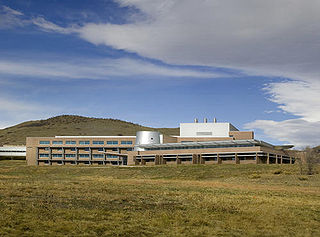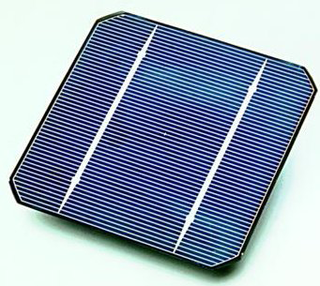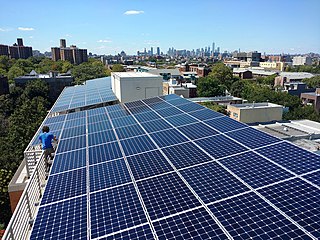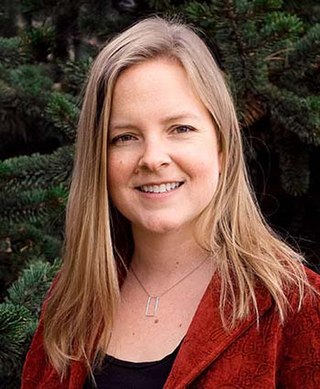Related Research Articles

The National Renewable Energy Laboratory (NREL) in the US specializes in the research and development of renewable energy, energy efficiency, energy systems integration, and sustainable transportation. NREL is a federally funded research and development center sponsored by the Department of Energy and operated by the Alliance for Sustainable Energy, a joint venture between MRIGlobal and Battelle. Located in Golden, Colorado, NREL is home to the National Center for Photovoltaics, the National Bioenergy Center, and the National Wind Technology Center.
In the 19th century, it was observed that the sunlight striking certain materials generates detectable electric current – the photoelectric effect. This discovery laid the foundation for solar cells. Solar cells have gone on to be used in many applications. They have historically been used in situations where electrical power from the grid was unavailable.

A solar cell or photovoltaic cell is an electronic device that converts the energy of light directly into electricity by means of the photovoltaic effect. It is a form of photoelectric cell, a device whose electrical characteristics vary when it is exposed to light. Individual solar cell devices are often the electrical building blocks of photovoltaic modules, known colloquially as "solar panels". Almost all commercial PV cells consist of crystalline silicon, with a market share of 95%. Cadmium telluride thin-film solar cells account for the remainder. The common single-junction silicon solar cell can produce a maximum open-circuit voltage of approximately 0.5 to 0.6 volts.

A solar panel is a device that converts sunlight into electricity by using photovoltaic (PV) cells. PV cells are made of materials that produce excited electrons when exposed to light. The electrons flow through a circuit and produce direct current (DC) electricity, which can be used to power various devices or be stored in batteries. Solar panels are also known as solar cell panels, solar electric panels, or PV modules.
Energy Conversion Devices, Inc. (ECD) was an American photovoltaics manufacturer of thin-film solar cells made of amorphous silicon used in flexible laminates and in building-integrated photovoltaics. The company was also a manufacturer of rechargeable batteries and other renewable energy related products. ECD was headquartered in Rochester Hills, Michigan.
MiaSolé is an American solar energy company selling copper indium gallium selenide (CIGS) thin-film photovoltaic products. MiaSolé's manufacturing process lays CIGS on a flexible stainless steel substrate. MiaSolé produces all layers of photovoltaic material in a continuous sputtering process.

Solar power includes solar farms as well as local distributed generation, mostly on rooftops and increasingly from community solar arrays. In 2023, utility-scale solar power generated 164.5 terawatt-hours (TWh), or 3.9% of electricity in the United States. Total solar generation that year, including estimated small-scale photovoltaic generation, was 238 TWh.

Michael Grätzel is a professor at the École Polytechnique Fédérale de Lausanne where he directs the Laboratory of Photonics and Interfaces. He pioneered research on energy and electron transfer reactions in mesoscopic-materials and their optoelectronic applications. He co-invented with Brian O'Regan the Grätzel cell in 1988.

Cadmium telluride (CdTe) photovoltaics is a photovoltaic (PV) technology based on the use of cadmium telluride in a thin semiconductor layer designed to absorb and convert sunlight into electricity. Cadmium telluride PV is the only thin film technology with lower costs than conventional solar cells made of crystalline silicon in multi-kilowatt systems.

Thin-film solar cells are a type of solar cell made by depositing one or more thin layers of photovoltaic material onto a substrate, such as glass, plastic or metal. Thin-film solar cells are typically a few nanometers (nm) to a few microns (μm) thick–much thinner than the wafers used in conventional crystalline silicon (c-Si) based solar cells, which can be up to 200 μm thick. Thin-film solar cells are commercially used in several technologies, including cadmium telluride (CdTe), copper indium gallium diselenide (CIGS), and amorphous thin-film silicon.
Narec, since 2014 known as the National Renewable Energy Centre, is a part of the Offshore Renewable Energy (ORE) Catapult, a British technology innovation and research centre for offshore wind power, wave energy, tidal energy and low carbon technologies. ORE Catapult's head office is in Glasgow, Scotland. The centre operates multi-purpose offshore renewable energy test and demonstration facilities. It is similar to other centres, such as NREL in the US and National Centre for Renewable Energies (CENER) in Spain. The National Renewable Energy Centre is based in Blyth, Northumberland.
Arthur J. Nozik is a researcher at the National Renewable Energy Lab (NREL). He is also a professor at the University of Colorado, which is located in Boulder. He researches semiconductor quantum dots at the National Renewable Energy Laboratory, and is a chemistry professor at the University of Colorado. He also does research for the advancement of solar energy, for which he won the Intergovernmental Renewable Energy Organization (IREO) Award for Science and Technology in 2009.
Christopher R. Wronski was an electrical engineer and Professor Emeritus at Pennsylvania State University, noted for his pioneering research in photovoltaic cells including discovery of amorphous silicon solar cell and the Staebler–Wronski effect.
Amonix, Inc. was a solar power system developer based in Seal Beach, California. The company manufactured concentrator photovoltaic (CPV) products designed for installation in sunny and dry climates. CPV products convert sunlight into electrical energy in the same way that conventional solar photovoltaic technology does, except that they use optics to focus the solar radiation before the light is absorbed by solar cells. According to a comparative study of energy production of solar technologies, CPV systems require no water for energy production and produce more energy per megawatt (MW) installed than traditional PV systems. Amonix had nearly 70 megawatts of CPV solar power systems deployed globally, including Southwestern U.S. and Spain.

Amorphous silicon (a-Si) is the non-crystalline form of silicon used for solar cells and thin-film transistors in LCDs.
Pauls Stradiņš Jr. is a physicist at the National Renewable Energy Laboratory in Golden, Colorado, and a foreign member of the Latvian Academy of Sciences.

At the time of commissioning in 2003, the 500 kW Chevron Solarmine solar photovoltaic (PV) system was the world's largest thin-film amorphous silicon solar PV system and one of the largest solar PV systems in the United States. Located at the Midway-Sunset Oil Field, Solarmine was the first solar PV system in California to power oil field operations.
David E. Carlson was an American physicist who invented thin film, amorphous silicon based, photovoltaic solar cells.

Emily Warren is an American chemical engineer who is a staff scientist at the National Renewable Energy Laboratory. Her research considers high efficiency crystalline photovoltaics.
Joseph J. Berry is an American scientist who is principal scientist at National Renewable Energy Laboratory. He leads the United States Department of Energy Solar Energy Technology Office program on perovskite solar cells, and is director of the U.S. Manufacturing of Advance Perovskites consortium.
References
- 1 2 Sarah Kurtz — Research Fellow, National Renewable Energy Laboratory, archived from the original on 2017-04-30
- 1 2 3 Anderson, Lorena (February 13, 2020), "National Academy of Engineering Elects Kurtz Into Its Ranks", Newsroom, University of California, Merced, retrieved 2020-10-26
- 1 2 "Sarah Kurtz", School of Engineering Faculty, University of California, Merced, retrieved 2020-10-26
- ↑ WorldCat catalog entry for Atmospheric pressure chemical vapor deposition of hydrogenated amorphous silicon, titanium nitride, and titanium dioxide thin films, retrieved 2020-10-26
- ↑ NREL Scientists Win Dan David Prize in Future Category, National Renewable Energy Laboratory, March 6, 2007, retrieved 2020-10-26; "2 NREL scientists take share of Dan David prize", Denver Post, March 6, 2007; "Laureates 2007", Dan David Prize, retrieved 2020-10-26
- ↑ NREL's Sarah Kurtz Wins Prestigious Cherry Award from IEEE, National Renewable Energy Laboratory, June 7, 2012, retrieved 2020-10-26
- ↑ "Sarah Kurtz, 2016 winner", Lifetime Achievement Award, US Clean Energy Education & Empowerment (C3E) Initiative, retrieved 2020-10-26
- ↑ "Professor Sarah Kurtz", Member profiles, National Academy of Engineering, retrieved 2020-10-26